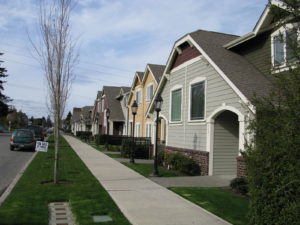
There’s no denying that we have a housing crisis in California and across the United States but the big question is what’s being done about it?
Thankfully, over the last three years developers are building more multifamily rental properties across the United States but, those properties are bigger than in years past and have 50 or more units.
In 2017 alone, there were 358,000 new multifamily units built in the United States but out of that number there were only 27,000 multifamily units built that had two to nine units. This statistic stands in sharp contrast to 1973 when there were 288,000 multifamily units built that were smaller and had under 50 units.
Why the Change?
Everyone knows that population growth dictates what developers do when brining more multifamily properties to the marketplace but why are fewer small multifamily properties being built in this day and age compared to years ago?
Much of the shift has to do with the rise of no-growth, not-in-my-backyard politics since the 1960s. This political movement has been strongest in homeowner-dominated suburbs, and as a result, as BuildZoom chief economist Issi Romem showed in a remarkable study earlier this year, almost all the housing construction in expensive, space-constrained coastal metropolitan areas such as Boston, Los Angeles, New York, San Francisco and Seattle is now happening in and around established urban centers.
The residential suburbs of these areas have effectively gone dormant, shunting new construction to the neighborhoods — mostly in or near old urban cores — where the neighbors either don’t object (because they’re in commercial buildings) or don’t have much political clout (because they’re low-income renters), and local elected officials see benefits in a growing population. In such places, big apartment buildings generally make more sense than duplexes. Also, as barriers to new construction — land costs, labor costs, permitting costs, zoning rules, Nimby opposition, etc. — have risen, the threshold project size needed to turn a profit has increased even in less expensive metro areas.
Another factor is that limited partnerships, limited liability companies, real estate investment trusts and the like have taken over from individuals as the dominant players in multifamily housing, and these institutional investors tend to be more interested in (and capable of) developing big projects than in building fourplexes here and there. Non-individuals owned 71 percent of all rental units in multifamily buildings and 94 percent of those in buildings with 50 or more units in 2015, when the Census Bureau last asked around, and those percentages have been rising since at least 2001. It’s apparent in the above charts (especially the third one) that the shift from small multi-unit buildings to big ones accelerated after the mid-1990s, which happens to be right after the Resolution Trust Corp., the government entity charged with cleaning up the aftermath of the savings and loan crisis, went to great lengths to create an institutional market for such properties.
Contact 36 North Property Management
Do you need property management for your rental properties in the Monterey County area? If so, contact 36 North Property Management by calling us at 831-484-4604 or click here.

